
 |
Philatelic History of Wilmington, North CarolinaRevised 11/26/2023 |
| (> 1859) Page 1 | (1860-1897) Page 2 | (1898-1916) Page 3 | (1917-1941) Page 4 | (1942-1971) Page 5 | (1972 >) Page 6 |
Philatelic Item |
It is our hope that this web-page will serve to stimulate an interest in the collecting, conservation and documentation of postal history covers of Wilmington.
Wilmington Philatelic Society |
|||
|---|---|---|---|---|
| Year | Pix | Cat # | Description | By |
| Civil War (War Between the States)
The 1860's saw the political strife of more than 40 years turn violent as the Northern states refused to allow the Southern states their own government. The struggle elevated Wilmington to national, even international prominence.
The North had declared a blockade of Southern ports. This was a serious threat to Southern hopes of independence. The agricultural economy of the South would not be able to support a war effort without imports. A way had to be found to keep a stream of supplies coming in.
|
||||
| 1860 |
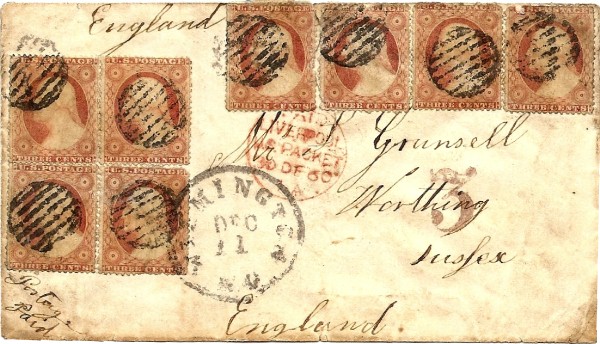
|
8x26 | A cover sent on December 1, 1860 from Wilmington to England. | GS |
| 1861 |
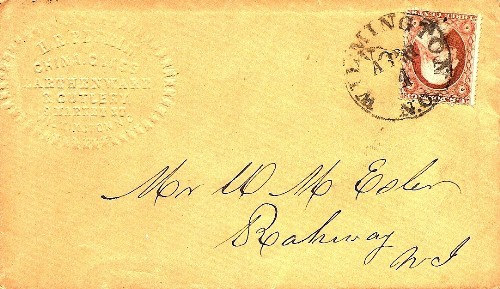
|
26 | A cover sent on April 4, 1861 by HR Perrin (China-Glass-Earthenware-Cutlery), 9 Market Street, Wilmington to WM Ester in Rahway NC. | GS |
| Eight days after the posting of the above cover, the Civil War between the north and south began with the northern bombardment of Fort Sumter on April 12, 1861.
|
||||
| 1861 |
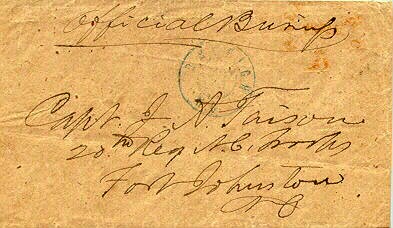
|
CSA-#68xul |
A cover sent during the Civil War from Raleigh NC to Fort Johnston NC. It has a Raleigh NC Handstamp PAID 5 Provisional in blue and red. Postal markings are somewhat weakly struck as is often the case and the date is not apparent. Light coarse paper cover with “Official Business” in manuscript across the top and a military address to Capt JA Faison, 20th Reg NC Troops Fort Johnston NC. Cover pix courtesy of John L Kimbrough, CSA Stamps & Postal History. History: The 20th NC Infantry was organized at Fort Johnston and received its designation as the 20th NC Infantry in November 1861. The regiment then joined the ANV in April 1862 as part of Garland’s Brigade of DH Hill’s Division and fought with the ANV (except during June through December 1864 when the regiment was part of Early’s Valley Campaign) all the way through to Appomattox Court House. Therefore this cover must date from either late NOV or DEC 1861 or very early 1862. There was a network of Forts protecting the Cape Fear River and water access to Wilmington. Fort Caswell was on the northern tip of Oak Island, Fort Johnston was adjacent to Smithville aka Southport and Fort Anderson was further up the river. On the other side of the Cape Fear River was Fort Holmes on Smith Island aka Bald Head Island, Fort Fisher on Federal Point (Confederate Point), Fort Meares, Fort Campbell, Fort Lee and Fort Davis. |
CSA |
| 1861 |
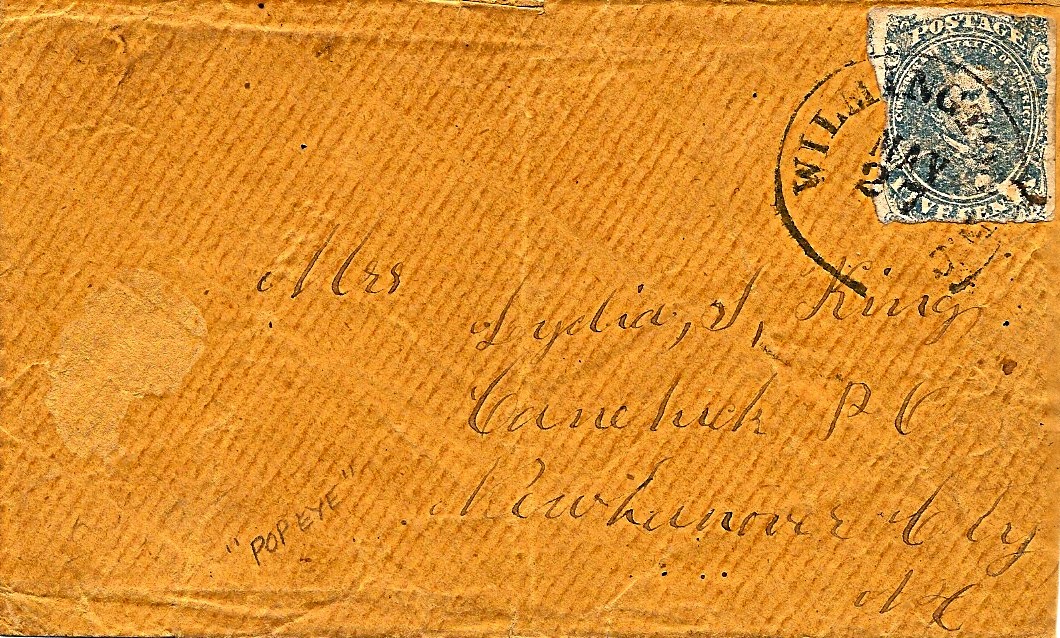
|
CSA-4 | A cover sent during the Civil War from Wilmington to Canetuck (Caintuck) NC. The cover bears a stamp issued by the Confederate States of America (#4). | GS |
| 1862 |
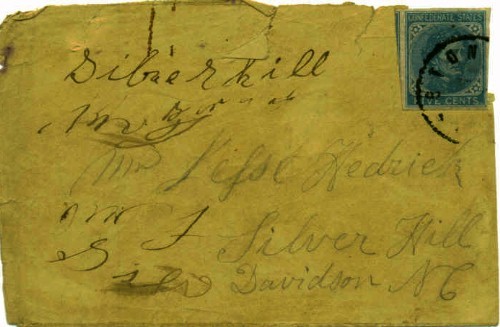
|
CSA-6 | A cover sent during the Civil War from Wilmington to Silver Hill in Davidson NC. The cover bears a stamp issued by the Confederate States of America (#6). | TB |
| 1863 |
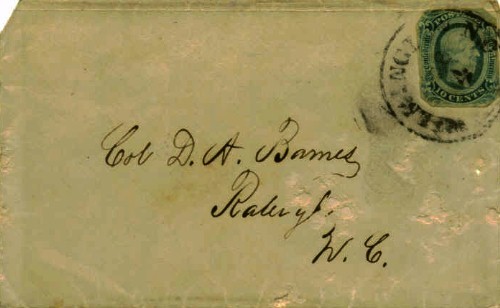
|
CSA-11D | A cover sent during the Civil War from Wilmington to Raleigh NC. The cover bears a stamp issued by the Confederate States of America (#11D). | TB |
| 1863 |
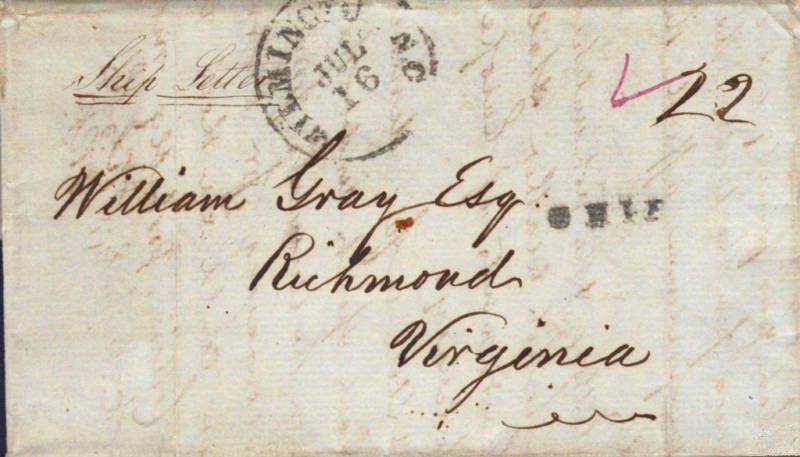
|
--- | A cover sent on April 27, 1863 from Liverpool Great Britain to Wilmington NC. It arrived in Wilmington on July 16, 1863 on the Blockade Runner, "Phantom" for further dispatch to William Gray in Richmond VA. This folded letter received a bold circular Wilmington receiver stamp over a manuscript "22" (double 10 cent rate being overweight plus 2 cent ship fee). Partial letter content: "the passing of the new tobaco law and how it would effect trade between America and other countries ... the failure at Charleston SC and the not unlikely evacuation of New Orleans LA may influence the governments of Europe to recognize the Confederacy ... " History: The blockade runner, "Phantom" was built in 1862 for Fraser, Trenholm and Company to become one of the original Confederate government steamers operated by the Confederate Ordinance Bureau between Bermuda and Wilmington NC. In early 1863 Mrs Rose Greenhow (a representative of the Confederacy) sailed from Wilmington to Bermuda on the "Phantom" with her small daughter on her way to Europe to promote plans to buy ships, guns and other supplies for the Confederacy with Confederate cotton certificates. She left Bermuda on a British man-of-war, later drowning on her return from Europe, off Wilmington, while on board the "Condor". The "Phantom" left Liverpool late in April 1863 on its third blockade run into the Cape Fear River. On September 23, 1983 near New Topsail Inlet above Fort Fisher she was chased ashore by the USS Connecticut. The "Phantom" crew set their ship on fire and escaped in lifeboats. |
OO |
| 1863 |
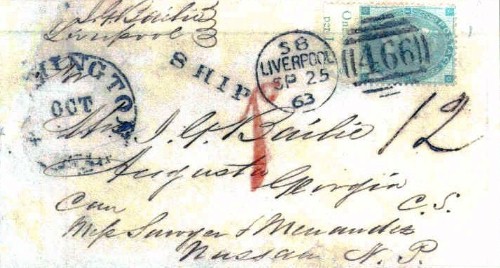
|
UK-42 | A cover sent on September 25, 1863 from Liverpool Great Britain to Nassau Bahamas via New York. It arrived in Nassau on October 14, 1863 and was placed on the Blockade Runner, "Fannie" arriving in Wilmington on October 22, 1863. (Wilmington Map - 1863) History: The iron paddle steamer blockade runner, Fannie was built in 1859 by Caird & Company, Greenock Scotland (originally named "Orion") for the Bee Company in Glasgow for service in the Baltic. In 1862 it was renamed "Fannie" and was based in Saint Georges Bermuda where it began service as a "blockade runner." |
WT |
| 1864 |
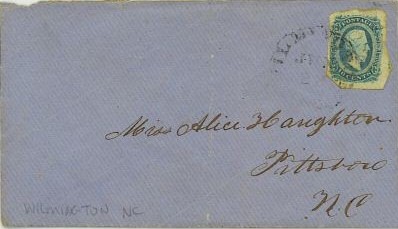
|
CSA-11 | A cover sent during the Civil War from Wilmington to Pittsboro NC. The cover bears a stamp issued by the Confederate States of America (#11). | OO |
| 1864 |
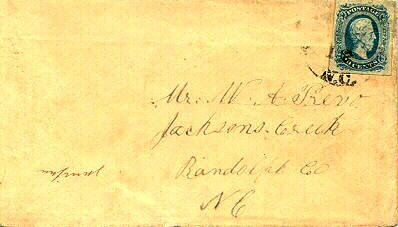
|
CSA-11 | Tied by a partial strike of the Wilmington NC - June 12, (1864). Addressed to Mr WA Prevo, Jacksons Creek, Randolph County NC. The original letter is included which is an short letter from a soldier son writing home to his father. The soldier is JM Prevo who is not listed as a regular NC soldier so must have been doing guard duty in Wilmington as part of the North Carolina State Militia. He is young and barely literate, but his letter is most interesting. Cover pix courtesy of John L Kimbrough, CSA Stamps & Postal History. Partial letter content: “...tel Mother to Make Me som shirts for i Am gitin bare...We can hear that the Yankees have got danville Va...We have move down close to Fort Fisher..” |
CSA |
| 1864 |
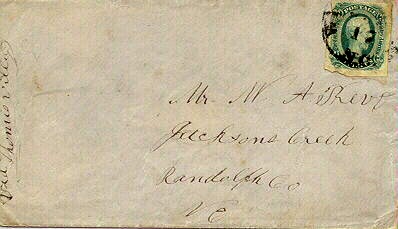
|
CSA-12 | Tied by a partial strike of the Wilmington NC - July 17, (1864). Blue paper cover addressed to Mr WA Prevo, Jacksons Creek, Randolph County NC. The original letter is included which is an short letter from a soldier son writing home to his father. The soldier is JM Prevo who is not listed as a regular NC soldier so must have been doing guard duty in Wilmington as part of the North Carolina State Militia. He is young and barely literate, but his letter is most interesting. Cover pix courtesy of John L Kimbrough, CSA Stamps & Postal History. Partial letter content: “...We have fore hundred of the 17 year old boys for gards a Round hear...the yankees landed up the sound last nite...was drove back Bey som Artillery...tel Mother when she Mak the new Pance to put straps on them for i cant ceap these on any mor.” |
CSA |
|
Wilmington remained open until the last months of the Civil War. In January 1865, the Northern Union navy staged a massive bombardment and assault of Fort Fisher. Fort Fisher fell on January 15, 1865, followed by the surrender of Wilmington on February 22, 1865. History: After Fort Fisher fell, the Union turned their gun-sights on capturing Wilmington. They advanced toward Wilmington following Federal Point Road. The Confederate troops took up a strong position at Forks Road aka Cross Roads near Jumpin' Run Creek, approximately three miles south of Wilmington to make one last stand in their effort to halt the Union Army's advance. One brigade of Confederate infantry and a battery of artillery under the command of Major General Robert F Hoke entrenched themselves. The Federals advanced with two brigades of US Colored Troops under the command of Brigadier General Charles J Paine and expeditionary forces under the command of Brigadier General Alfred H Terry. The Union and Confederate forces met at the Battle of Forks Road aka the Battle of Jumpin' Run. Hoke's troops finally withdrew allowing Terry to enter Wilmington on February 22, 1865 where he accepted the surrender of Wilmington from Mayor John Dawson. Pix from the recreation of the Battle of Forks Road February 22-24, 2008 in Wilmington, North Carolina Visit the Cape Fear Civil War Roundtable Visit the Cape Fear Historical Institute |
||||
| 1865 |
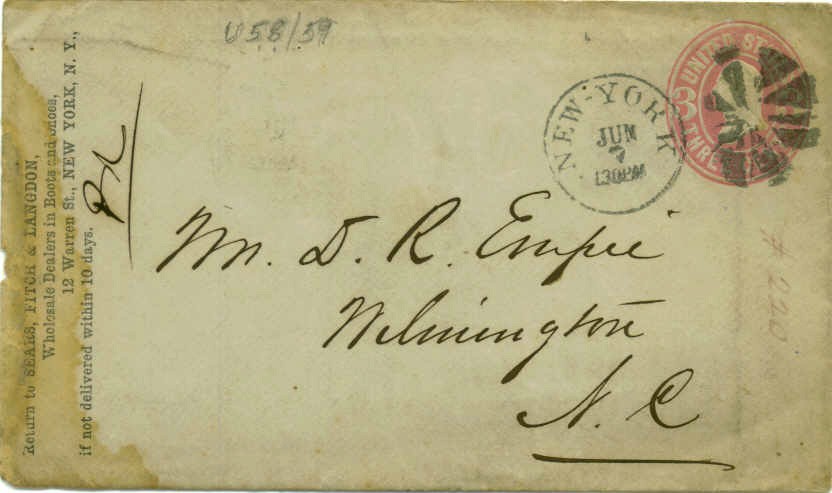
|
U-58~59 | A cover sent on June 7, 1865 by Sears, Fitch & Langdon, 12 Warren St, New York City (wholesale dealers in boots and shoes) to D R Empie in Wilmington NC. Empie Historical Marker. | FO |
| 1865 |
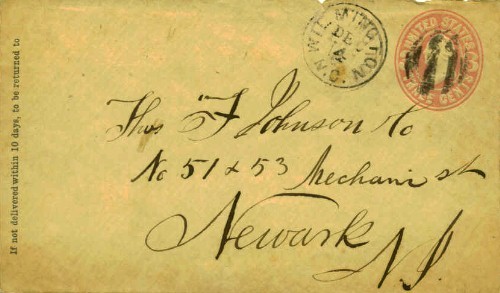
|
U-59 | A cover sent on December 4, 1865 from Wilmington to Newark NJ. | TB |
| Wilmington changed from a township and officially became a city on February 10, 1866. That same year the Wilmington Post newspaper was established. The Morning Star newspaper was founded a year later in 1867. The first Wilmington fire company that had been organized in 1847 was chartered in 1867 as the Wilmington Hook and Ladder Company.
|
||||
| 1867 |
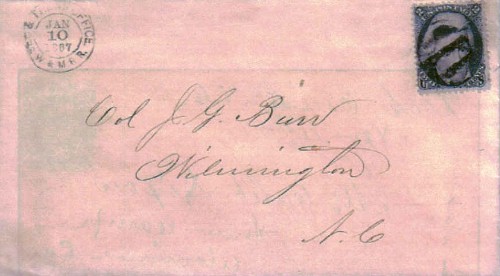
|
73 | A cover sent to Wilmington and canceled on January 10, 1867 from the Wilmington & Manchester Railroad. History: The Wilmington & Manchester Railroad was one of the earliest railroads in North Carolina. It began operation in 1851/52 with rails extending from Wilmington west to Manchester SC. It was completed in 1854 and after the Civil War, its rails were extended to Augusta GA. Visit the Wilmington Railroad Museum. |
WT |
| 1868 |
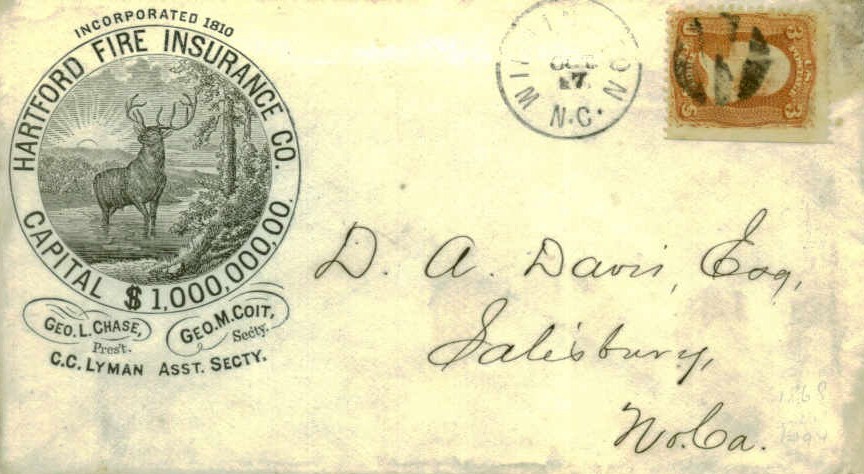
|
65 | A cover sent from EP George in Wilmington canceled on October 7, 1968 to DA Davis Esq in Salisbury NC. History: In 1810 the Connecticut General Assembly awarded a charter to the state's first publicly owned insurance firm, the Hartford Fire Insurance Company. The Aetna Fire Insurance Company opened for business nine years later. Fire insurance policies were sold to clients through insurance agents. Merchants, bankers and other professionals often acted as part-time insurance agents prior to the start of the Civil War in 1861. Henry Russell Savage was the Wilmington NC agent for the Hartford Fire Insurance Company from 1836 through 1861 and was the cashier of the Bank of Cape Fear from 1847 to 1861. DeRossett & Brin were the Wilmington agents for the Aetna Insurance Company from 1855 to 1861. In the antebellum (before the war) period insurance saw no boundaries between the south and the north. In 1861 Robert E Lee, commander of the Confederate forces during the Civil War purchased a Hartford insurance policy for his family home known as "Arlington" (now part of Arlington National Cemetery) as did Abraham Lincoln who purchased a policy to protect his home in Springfield IL. During the Civil War (April 1861 - January 1865) northern insurance companies suspended their operations in the south. The postbellum (after the war) period of reconstruction saw the gradual re-configuration of relations between the north and the south. EP George was the Hartford Fire Insurance Compay Wilmington agent in 1868. In 1868 the Hartford elk-fording-a-stream logo resembled an elk, popularized in an 1851 painting by Sir Edwin Landseer called "The Monarch of the Glen." Letter content: Wilmington NC, October 6, 1968, DA Davis Esq, Salisbury NC, Dear Sir, A friend informs me there is a man who will give 75 cents for a few City Wilmington Bonds of the new 8% issue. He will not however pay any commission over the 75 cents. If you or your friends still feel disposed to him some bonds with funds at this figure, allowing me commission for effecting sale, I shall be glad to hear from you. Please write me at your earliest convenience. Yours very truly, EP George |
RP |
| 1869 |
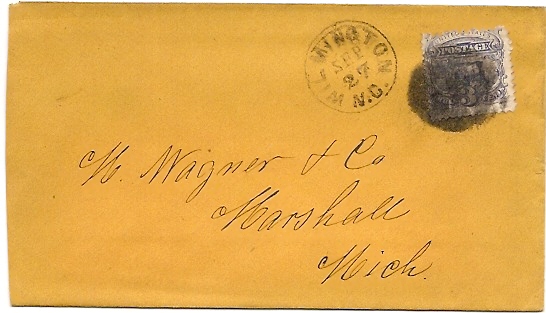
|
114 | A cover sent on September 27, 1869 from Henry Stolter in Wilmington to Wagner & Co in Marshall, Michigan. His letter states,"you oblige me by sending me a catalog of your wonderful inventions." | GS |
| 1869 |
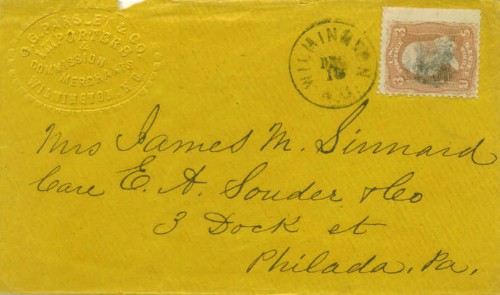
|
65 | A cover sent on December 18, 1869 by OG Parsley & Co, 8 Water St, Wilmington (Importers & Commission Merchants) to James M Sinnard in Philadelphia PA. OG Parsley operated saw mills and sold lumber, wood, coal and fertilizers. | WT |
| 1870 |
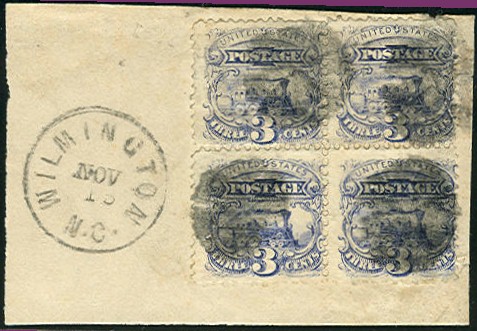
|
114 | A block of stamps (Scott #114) cancelled on November 15, 1870 in Wilmington NC. History: The Wilmington & Manchester Railroad was one of the earliest railroads in North Carolina. It began operation in 1851/52 with rails extending from Wilmington west to Manchester SC. It was completed in 1854 and after the Civil War, its rails were extended to Augusta GA. Scott #114 was the first US postage stamp that depicted a railroad engine. |
OO |
| 1873 |
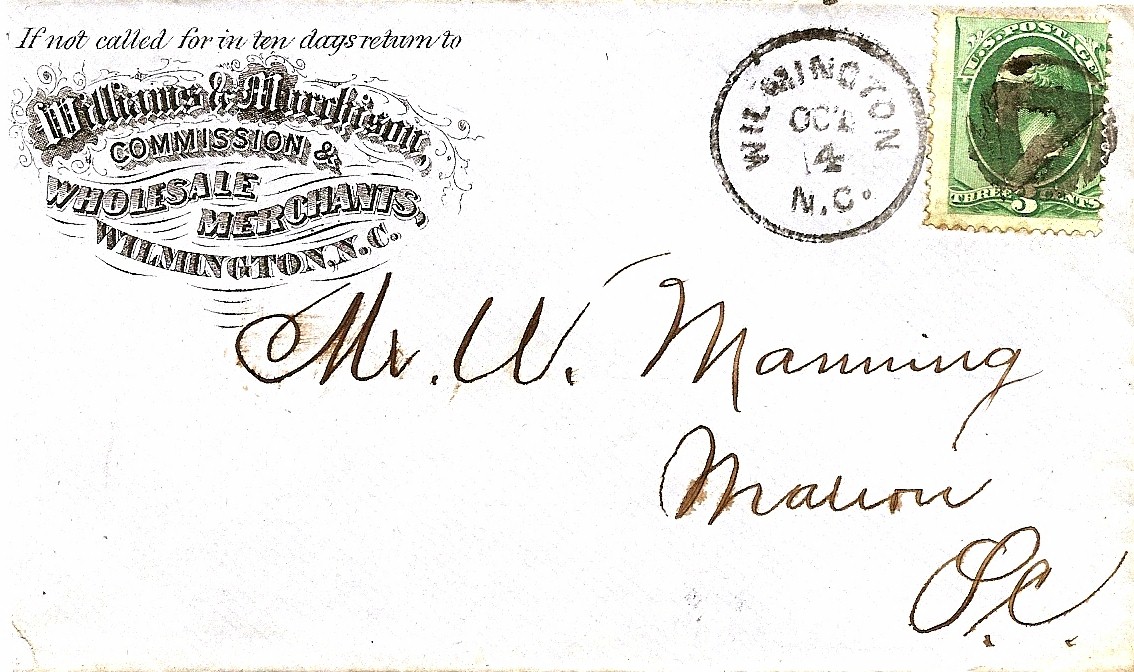
|
158 | A cover sent on October 4, 1873 by Williams & Murchison (Commission & Wholesale Merchants) to W Manning in Marion SC.
History: Williams & Murchison was a Wilmington merchant with its shop located at 6/7 North Water Street. Advertising Flyer 1 & 2. |
GS |
| 1874 |
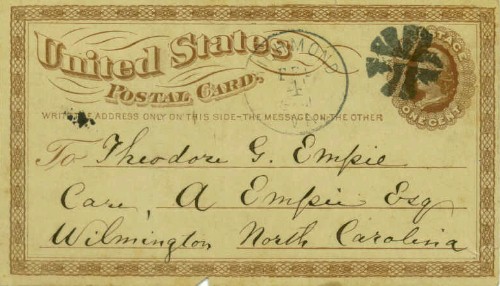
|
UX-3 | A postal card sent on February 4, 1874 by "Dintie" from Richmond VA to Theodore G Empie (in-care-of Adam Empie) in Wilmington NC. | WT |
| 1874 |
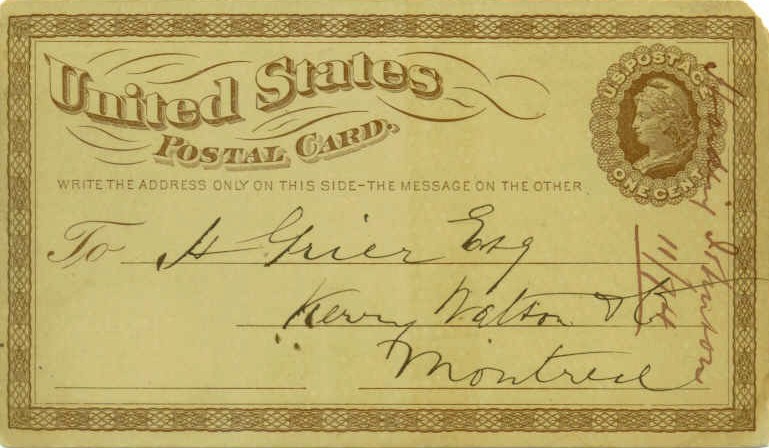
|
UX-3 | A postal card sent inside an outer cover to Montreal Canada. On the reverse of the postal card was a quotation for turpentine, rosin, tar, pitch, rosin oil, naptha, and marine paint. The card quotation is signed by Harding Johnson who dated his quotation, November 17, 1874. History: Johnson was a Wilmington merchant with his shop located on Nutt Street between Mulberry and Walnut Streets. He lived on Chesnut Street between Third and Forth Streets. |
WT |
| 1875 |
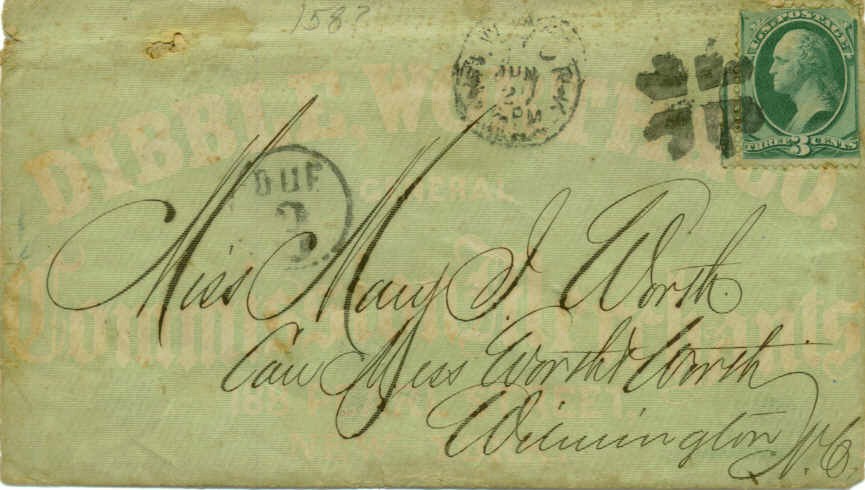
|
158 | A cover sent on June 2, 1875 by Dibble, Worth & Co, 188 Pearl Street, New York City (general commission merchants) to Miss Mary Jane Worth in Wilmington NC. History: During the Civil War, David Gaston Worth made peanut oil in Wilmington selling it throughout the south. In 1870 David G Worth and CB Dibble of Granby CT formed Dibble, Worth & Co. In 1872 they were forced to suspend business because of heavy debt. They moved from Wilmington to New York City to work-off their indebtedness, subsequently prospered and returned to Wilmington in 1876. Charles W Worth purchased the property at 412 South Third Street in Wilmington in 1889. He demolished the existing home and built a Queen Anne-style home which was completed in 1893. On November 23, 1897 David G Worth died and the company was re-named The Worth Company with BG Worth, president and Charles W Worth, manager. Mary Jane Worth was one of the seven children of BG Worth who later married William J Woodward. The Worth family resided in their Third Street home until 1930. In 1985 it became a bed and breakfast. |
RP |
| 1876 |
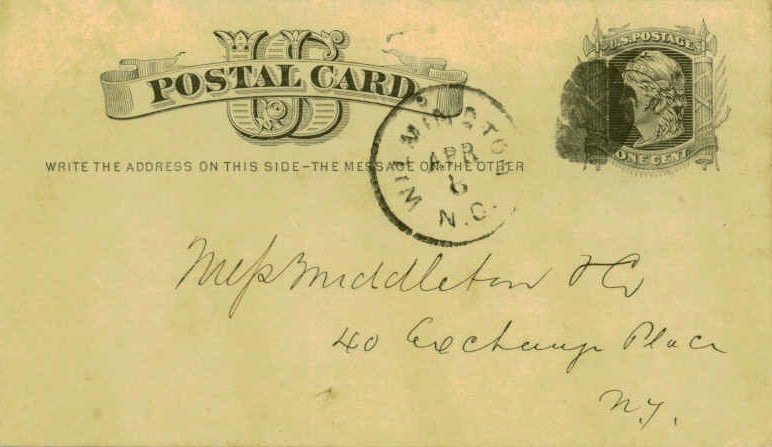
|
UX-5 | A postal card sent on April 8, 1876 by Northrop & Cumming, Wilmington to Middleton Co in New York City NY. History: Samuel & William H Northrop and William A Cumming were proprietors for the Steam Saw & Planing Mills as well as commission merchants for corn, cotton and naval stores. Message side and Advertising Ad |
WT |
| 1876 |
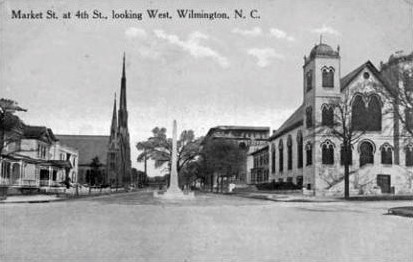
|
--- | A post card (picture circa 1910) of the Temple of Israel dedicated in Wilmington on May 12, 1876. History: The Temple of Israel on the corner of Fourth and Market Streets in Wilmington NC is the oldest Synagogue in North Carolina. Sephardic Jews arrived in North Carolina early in the 18th century. In 1852 a Jewish Burial Society was formed in Wilmington with a Hebrew Cemetery opening in 1855. An Orthodox Jewish congregation was formed in 1867 lasting for a few years. German Jews formed a Reform congregation in 1872 and three years later in 1875 laid the cornerstone of the Temple of Israel. The building was a combination of Greek Revival and Moorish architecture, unique in Wilmington. It features horseshoe arches and twin towers topped with golden onion domes. |
OO |
| 1879 |
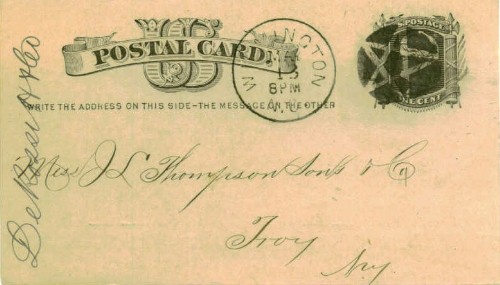
|
UX-5 | A postal card sent by DeRosset & Co on May 13, 1879 from Wilmington to JL Thompson & Co in Troy NY. The postal card received a hand-carved star cancel struck in black ink. History: The reverse of the postal card is a quotation covering spirits-turpentine, rosin, navy pitch, tar and peanuts. For details of the DeRosset family see the 1850 cover above. |
WT |
| 1879 |
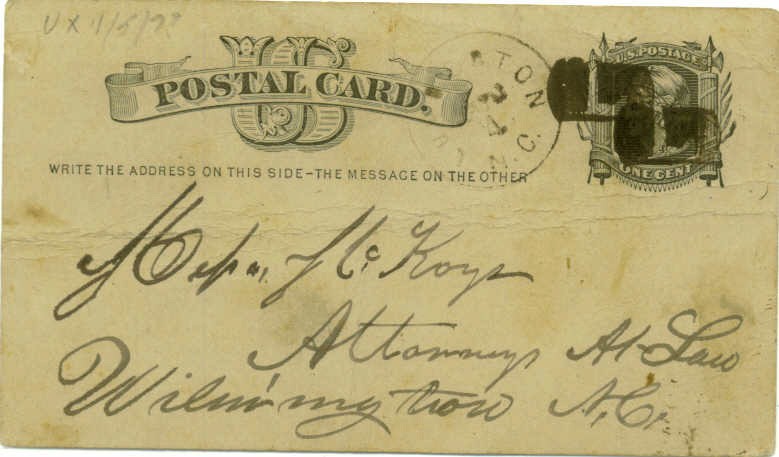
|
UX-5 | A postal card sent on June 3, 1879 from Wilmington to William Berry McKoy in Wilmington NC. History: McKoy was a prominent attorney in Wilmington. He was a well-known figure in the State Democrat Party and in the Masonic Order. He was born in Wilmington on December 24, 1852, graduated from Princeton University in 1876 and was admitted to the Bar in 1879. Although a member and chairman of the Democrat executive committee, he avoided office holding, preferring to remain an active attorney. He was involved with the development of the Masonic Order in North Carolina and the origins of Lodge #319 and other lodges in the Wilmington area. William Berry McKoy had two sons, James Hasell (see 1938 below) and Henry Bacon (see 1914 below). |
FO |
| 1879 |
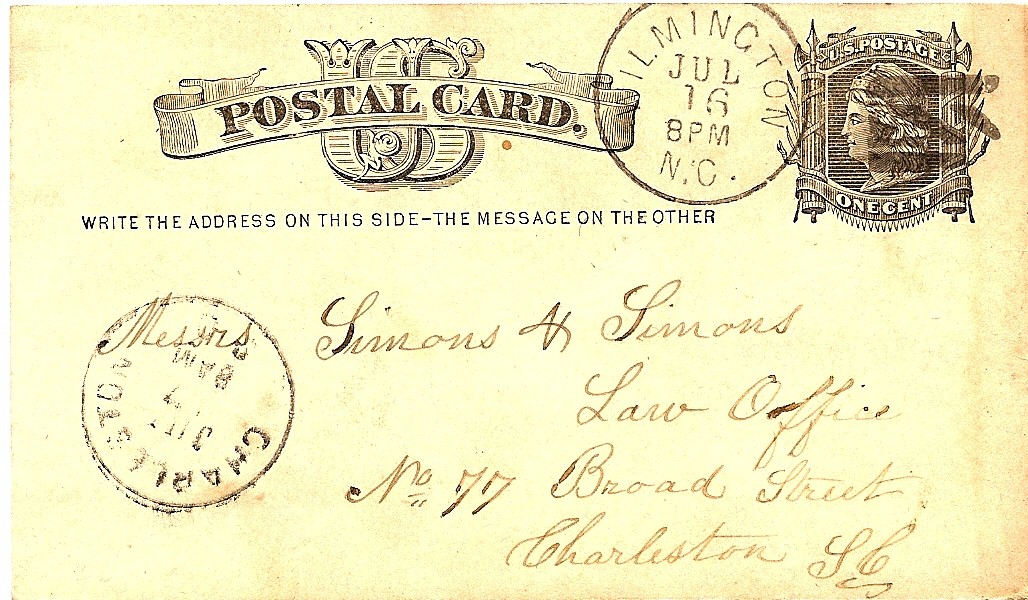
|
UX-5 | A postal card sent by Caroline Sampson on July 16, 1879 from Wilmington to the Simons & Simons Law Offices in Charleston SC. The postal card received a hand-carved fancy cancel struck in black ink. Message Content: Request for information concerning an interview with TB Maxwell in regard to my affairs. Please favor me with a line as soon as possible for I am more than anxious to have my business settled. |
GS |
| On August 31, 1886 Wilmington experienced an earthquake which lasted for about 30 seconds followed by several shorter after-quakes. The focal point of the quake was in Charleston SC. | ||||
| 1886 |
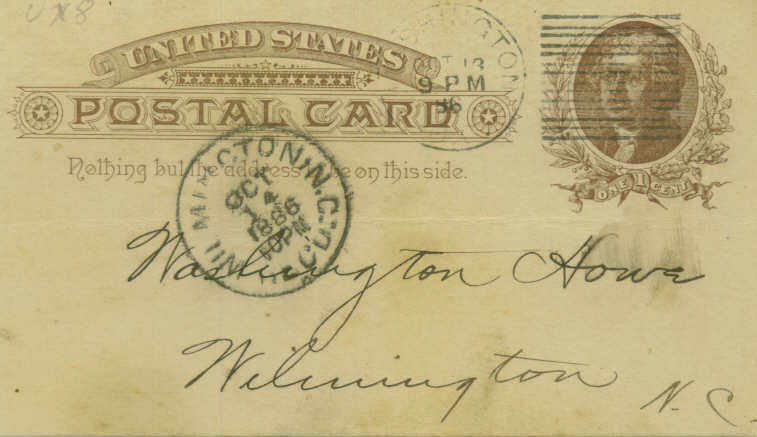
|
UX-8 | A postal card sent on October 13, 1886 from Washington DC to Washington Howe in Wilmington NC. | FO |
| 1888 |
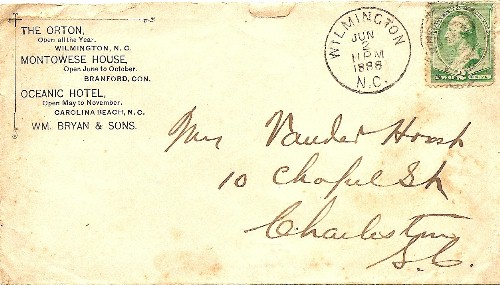
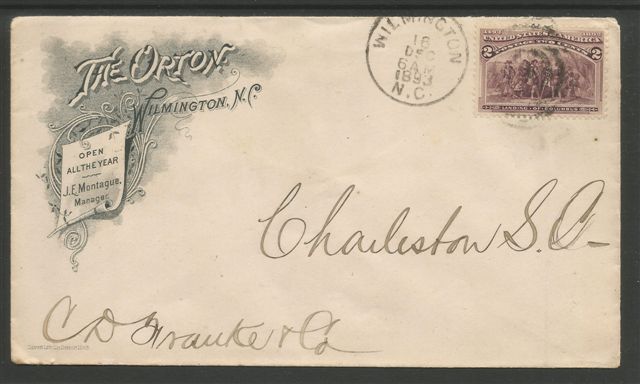
|
213 | A cover sent on June 2, 1888 from the Orton
Hotel in Wilmington to Charleston SC. Below is another cover sent on December 16, 1893 from the Orton Hotel to Charleston SC.
History: The Orton Hotel in downtown Wilmington was first opened in 1885 by Colonel KM Murchison. At that time, he also owned the Orton Plantation in Brunswick County and named his hotel after his plantation. In 1888 Murchison completed a new hotel building at 131 North Front Street just north of the original hotel. In 1905 he sold the hotel to Joseph Hinton. For many years the Orton was the premiere hotel in Wilmington and was expanded and modernized. It slowly lost some of its luster as newer and more modern hotels were built. By the middle of the 20th century, it was run down and much of the ground floor was being used as retail store fronts. On January 21, 1949 a raging fire destroyed all but the first floor and basement. The basement then housed a pool-room and pub, both of which were rumored to be haunted. |
GS JJ |
| 1890 |
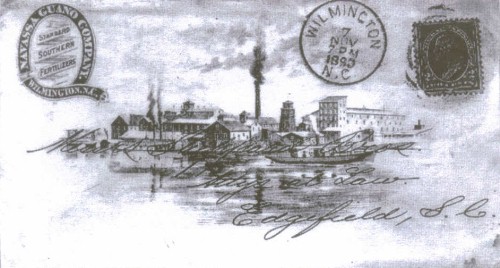
|
220 | A cover sent by the Navassa Guano Company on November 7, 1890 from Wilmington to Edgefield SC. History: Guano is the name given to the collected droppings of seabirds, bats and seals. It is highly prized as an effective fertilizer or gunpowder ingredient due to its high levels of phosphorus and nitrogen. Superphosphate made from guano is used for aerial topdressing. Soil that is deficient in organic matter can be made much more productive by the addition of this manure. Guano consists of ammonia, along with uric, phosphoric, oxalic, and carbonic acids, as well as some earth salts and impurities. Navassa Island is located off the west coast of Haiti in the Caribbean Sea and was owned by the Navassa Guano Company and its stock-holders. The US claimed that Navassa was an unorganized unincorporated territory but Haiti has also laid unsuccessful claim to the island. The Navassa Guano Company was initially set-up in Baltimore MD and then in Wilmington. See advertisement. The Spanish-American War of 1898 forced the guano operations of Navassa to evacuate and subsequently file for bankruptcy. Navassa Island was abandoned in 1901 and went into private ownership. It became significant again with the opening of the Panama Canal in 1914 (see 1914 below). |
WT |
| 1891 |
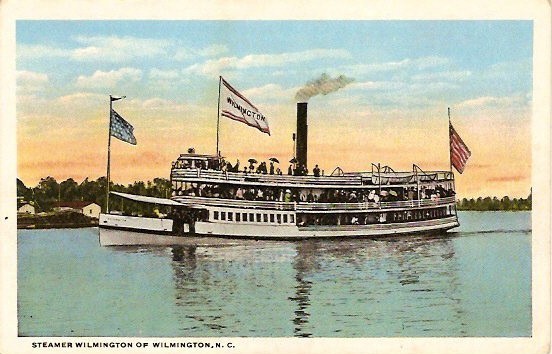
|
--- | A post card (circa 1912) of the Steamer Wilmington.
History: The Steamer Wilmington was owned and captained by John W Harper (1856-1917). Harper purchased the steamer in Wilmington DE. It was already named "The Wilmington" before arriving at the wharf at the foot of Market Street in Wilmington NC on April 28, 1891. The Wilmington was built in 1882 as an iron steamer (130 feet long, a beam of 23 feet drawing 6 feet of water) that could travel 16 miles per hour. While at Wilmington NC, Harper made two daily excursion trips to a wharf on the Cape Fear River with access to Carolina Beach and then continued down the river to Smithville (Southport) before returning to Wilmington. Both passengers and mail were transported on the Wilmington. |
JJ |
| 1892 |
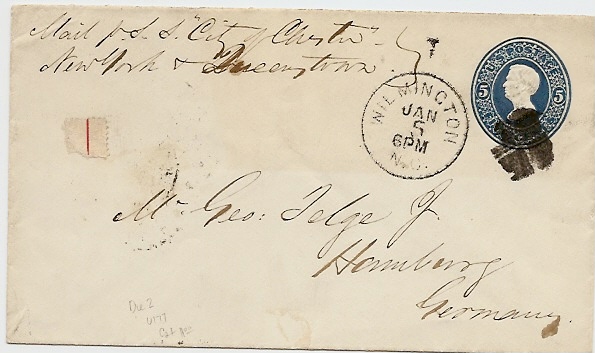
|
U172/80 | A cover sent on January 5, 1892 from Wilmington to Hamburg Germany. The TransAtlantic voyage was made on the steamship "SS City of Chester" sailing between New York and Queenstown. | GS |
| 1893 |
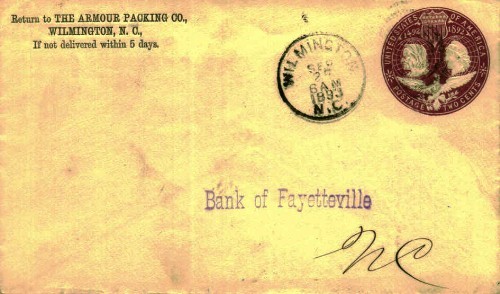
|
U-349 | A cover sent on September 27, 1893 from the Armour Packing Co in Wilmington to the "Bank of Fayetteville" NC. History: The Armour Packing Company, incorporated in New Jersey had its principal facilities in Kansas. In Kansas it slaughtered animals, dressed, cured, packed and prepared the products of their carcasses for food and other purposes. The fresh and cured meats including hams, dry salt sides, bacon, lard and beef extracts were then shipped in bulk to, amongst other places, five locations in North Carolina (Greensboro, Asheville, Charlotte, Fayetteville and Wilmington). In Wilmington, Armour Packing had a cold storage plant and warehouse and from these storage facilities, commission merchants and brokers sold Armour's products for both in-state and export distribution to the public. |
TB |
| 1893 |
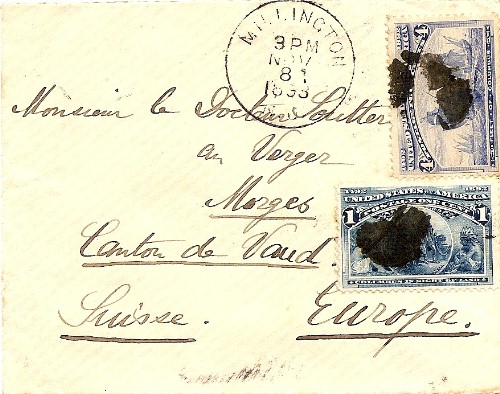
|
230 & 233 | A cover sent on November 8, 1893 from Wilmington to Morges Switzerland (by Lake Geneva). | GS |
| 1894 |
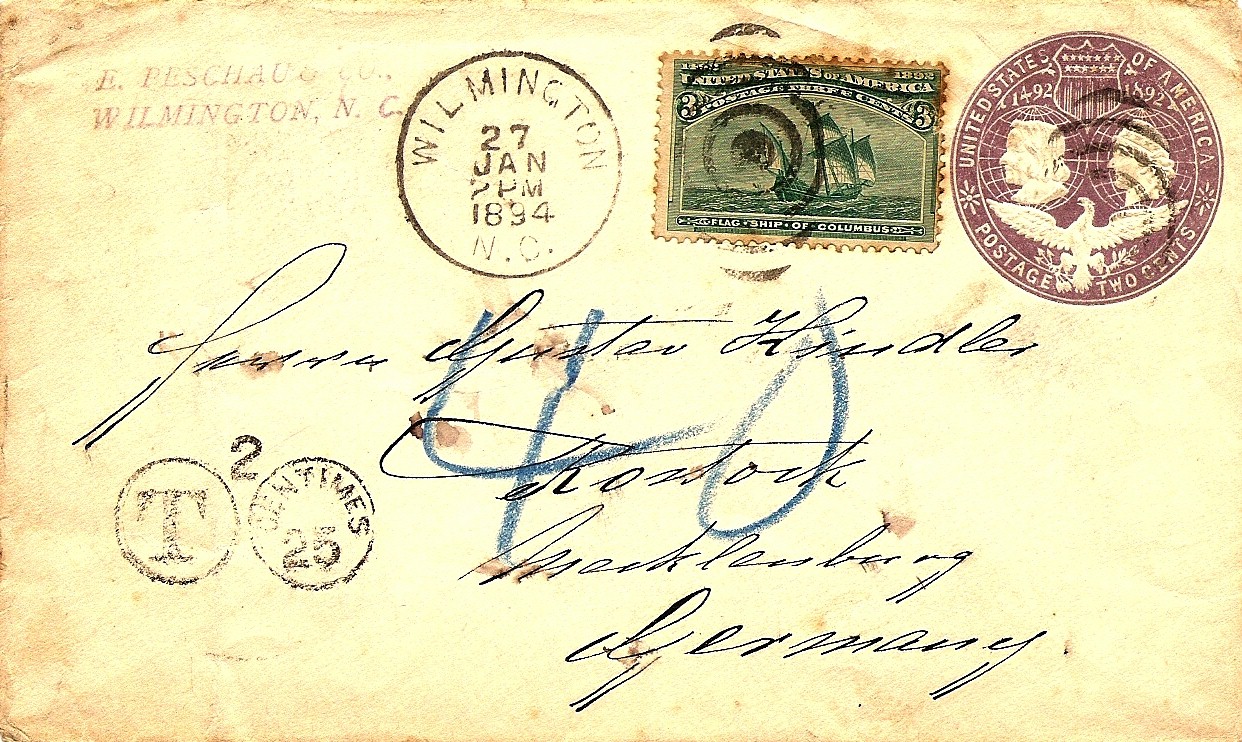
|
U-349 232 |
A cover sent on January 27, 1894 by E Peschau (wholesale, retail grocer & liquor dealer) 36 N Water Street from Wilmington to Mecklenburg Germany. | GS |
| 1894 |
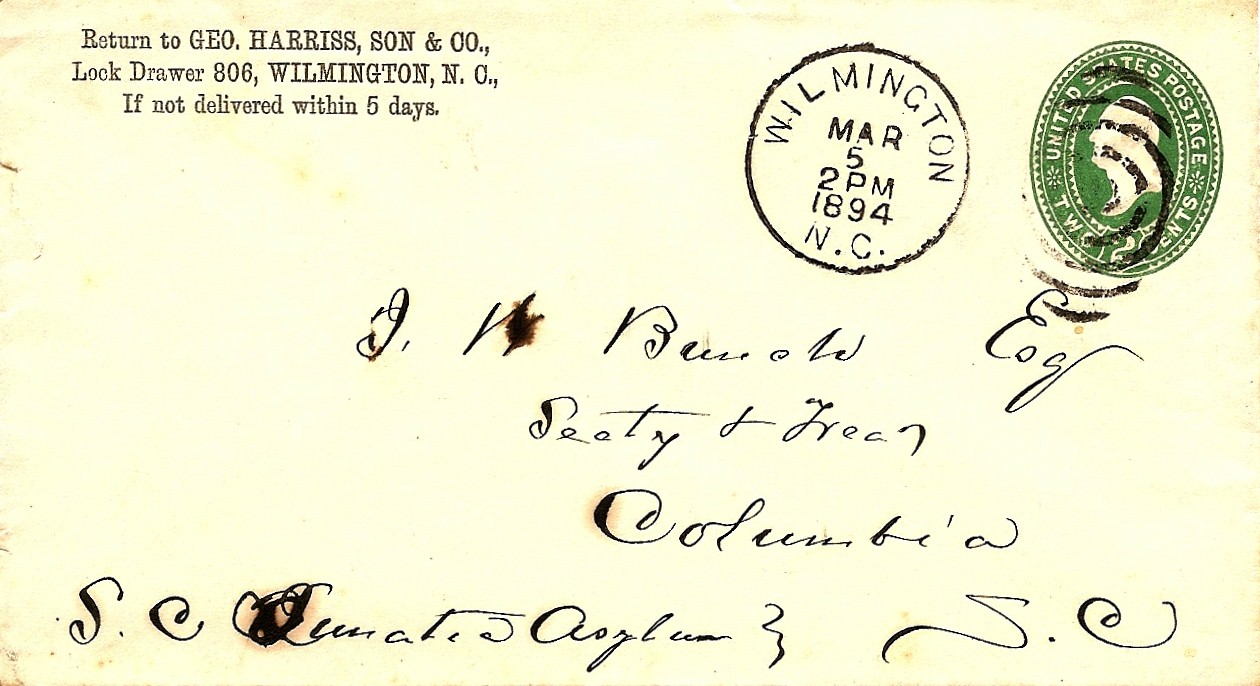
|
U-318 | A cover sent on March 5, 1894 by George Harriss, Son & Company from Wilmington to Columbia SC. | GS |
| 1894 |
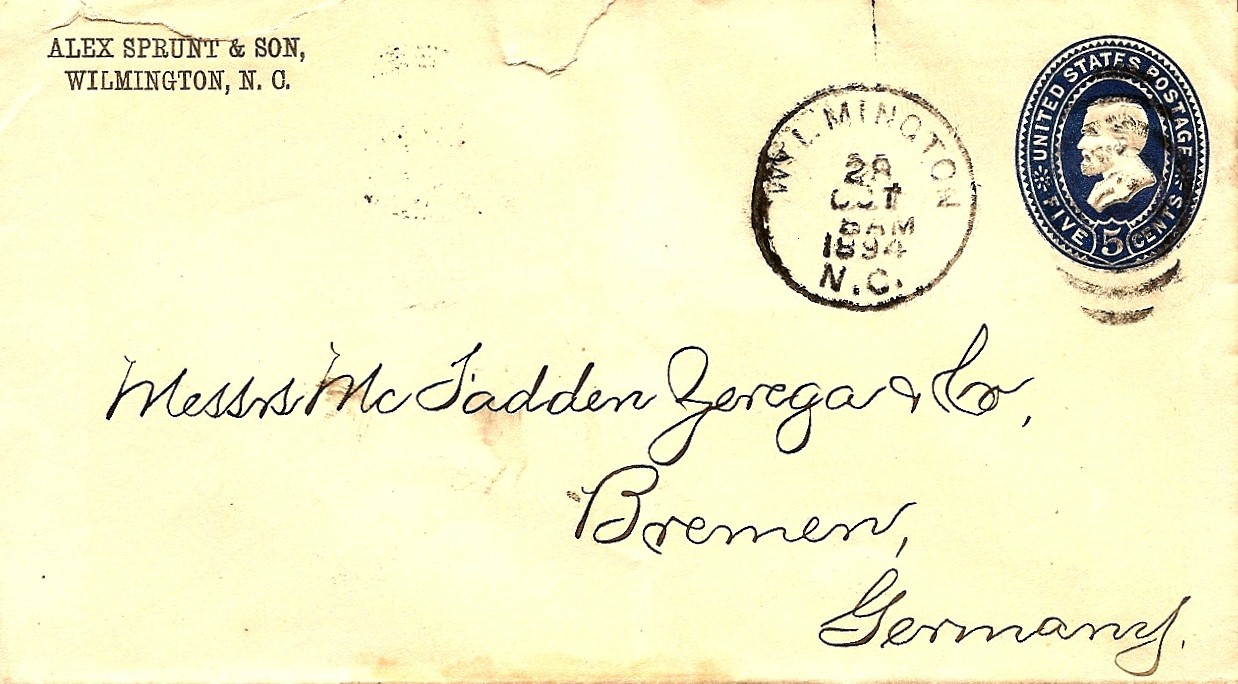
|
U-330 | A cover sent on October 28, 1894 by Alex Sprunt & Son from Wilmington to Bremen Germany. | GS |
| 1895 |
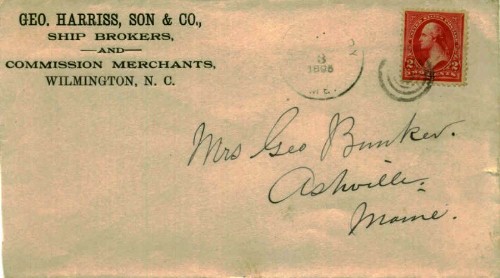
|
220 | A cover sent in 1895 from the George Harriss, Son & Co of Wilmington to Ashville ME. Harriss was a ship broker and commission merchant in Wilmington. | TB |
| (> 1859) Page 1 | (1860-1897) Page 2 | (1898-1916) Page 3 | (1917-1941) Page 4 | (1942-1971) Page 5 | (1972 >) Page 6 |